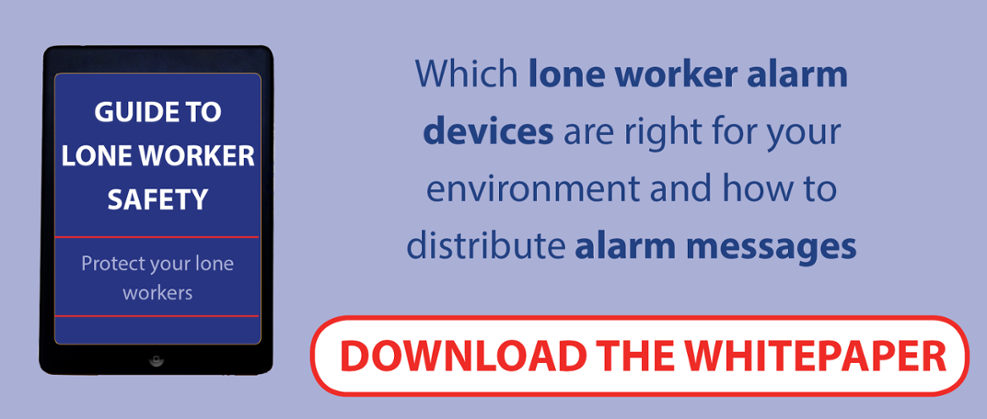
One of the most important issues within the food and beverage manufacturing industry is ensuring the safety of lone workers. But what are the potential hazards facing lone workers and how might you guarantee your lone workers' safety? We will provide an outline of this extremely important issue and highlight some of the potential solutions within the food and beverage manufacturing industry.
Definition of a lone worker
So what is a lone worker? A lone worker refers to an employee who usually works without the supervision from, or contact of, another employee within your organisation. As these workers will generally work unsupervised, the safety risks can be greater for these employees. Although, surprisingly, most workplace regulations within the UK typically do not extend to lone workers, care must be taken to ensure that the safety of lone workers is not compromised. The worst-case scenario is that any safety breaches may result in a large fine, or worse, for your business.
Lone worker risks within the food and beverage manufacturing industry
There are specific risks which lone workers will be exposed to as part of their duties, which are unique to the food and beverage manufacturing industry. These particular risks will be specific to the nature of your business; for example, for a company which manufactures frozen food products, then these specific risks might include situations where members of staff are required to enter low-temperature cold storage rooms or freezers unaccompanied. Or alternatively, in a factory which produces bakery goods, it may be that lone workers are required to operate high-temperature ovens, or may need to use potentially dangerous cutting equipment, on an unaccompanied basis. For lone workers who are involved with the manufacturing of drinks, it may be the case that exposure to large quantities of water, or the use of potentially dangerous chemicals, are part of routine duties by lone workers.
So what can you do within your business to ensure that lone workers are adequately protected and guarantee your lone workers' safety? Whilst we have outlined some of the potential risks which are facing lone workers within the food and beverage manufacturing industry, the most obvious starting point for your business is to conduct a thorough evaluation of the specific risks facing lone workers withinyourspecific business. Which duties do your lone workers perform? For example, are your lone workers required to use potentially dangerous pieces of equipment? If so, is the equipment tested regularly and is it maintained to the highest possible standards? Or are your lone workers required to perform heavy lifting duties in their role? Importantly, how long are lone workers left unaccompanied for? However, you should certainly consider any other events which might happen to your lone workers. These events might include falls, slips, physical or verbal abuse from other individuals, or even a stroke, or a heart attack? And should such an event happen, who could or should respond?
Lone worker policies and implementation
Once you have identified the specific risks facing your lone workers, the next step is to ensure that your business has a policy in place for ensuring the safety of your lone workers. This policy should be detailed and specific and should clearly explain what your workers need to do to keep themselves safe when performing their duties. Importantly, any policy should clearly explain what actions need to be taken, and by whom, in the event of an emergency. Remember, some of these events could be fatal. Once a lone worker policy has been created, it is extremely important to ensure that it is implemented in the correct manner, which is done by training all members of staff and regularly testing their knowledge of the policy.
Modern technological solutions: lone workers alarm solutions
Whilst having a lone worker policy is necessary, should the worst case scenario happen to a lone worker, how do you raise the alarm in a reliable and effective manner? Relying on an outdated alarm bell system, for example, is an inefficient and risky method of requesting help when it is needed the most. Thankfully, modern lone worker alarm systems can provide a robust and effective method of requesting help, however, a recent survey found that only approximately 6% of the UK’s lone worker employees were protected using a suitable lone working alarm device. So how might this work within the context of a food and beverage manufacturing company?
We have been responsible for the implementation of a bespoke lone working alarm system within the leading whisky manufacturer Tamdhu, who are located in a remote region of Scotland and typically have employees working unaccompanied. Due to the location of the business, the mobile phone signal could not be relied upon in the event of an emergency, so we implemented a DECT-based solution as this matched the customer’s requirements more than the other platforms available. This included DECT handsets that were fitted with panic buttons and tilt sensors that can raise alerts to inform colleagues of an emergency. Alarms can even be raised if the user is rendered unconscious, by the handset remaining in a horizontal position (or beyond a certain angle) for specific period of time. Furthermore, alarms also detail where the accident is, making it easier to find the injured person when the tilt sensor or panic button is activated.
Additional benefits of lone worker alarm systems
You may also not have considered the other benefits which a lone worker alarm system can bring to your business. For example, we also worked with a drinks manufacturing company in order to install a DECT-based lone worker alarm system and whilst the primary consideration for this system was to ensure the safety of lone workers, the company found that it helped improved site wide mobile communication too. This was an unexpected and they were surprised by how much improving communication was able to increase productivity across the business.





